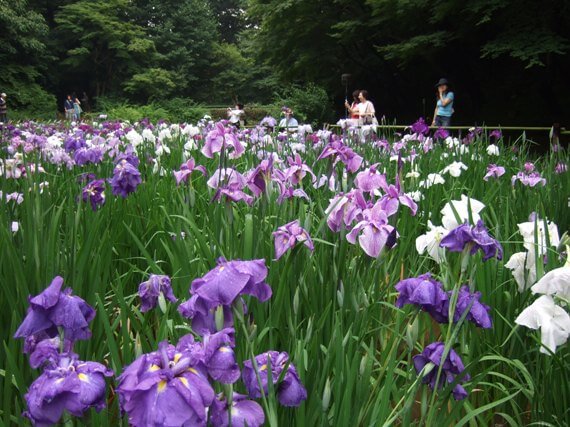The Japan Meteorological Agency has announced that the cherry blossoms are probably going to open early this year–prepare for falling-down-drunkness and inescapable karaoke in t – 6 days:
The JMA announced the dates that cherry (Prunus serrulata) blossoms are expected to open from Kyushu through the Tohoku region on 15 March. For the first time, this year’s blossoms are predicted to open between 1 and 4 days earlier than the average in Tohoku.
…
The projected date for blossoms to open in Tokyo and Yokohama is 22 March.
There are scores of classic poems about cherry blossoms–in the seasonal-devotion sense. But of course, they’re so woven into Japanese culture in March and April that they can become aesthetic placeholders for poems with other themes.
The following is the first poem I ever read and understood (at least lexically) in Japanese:
レモン哀歌
そんなにもあなたはレモンを待つてゐた
かなしく白いあかるい死の床で
私の手からとつた一つのレモンを
あなたのきれいな歯ががりりと噛んだ
トパアズいろの香気が立つ
その数滴の天のものなるレモンの汁は
ぱつとあなたの意識を正常にした
あなたの青く澄んだ眼がかすかに笑ふ
わたしの手を握るあなたの力の健康さよ
あなたの咽喉に嵐はあるが
かういふ命の瀬戸ぎはに
智恵子はもとの智恵子となり
生涯の愛を一瞬にかたむけた
それからひと時
昔山巓でしたやうな深呼吸を一つして
あなたの機関ははそれなり止まつた
写真の前に挿した桜の花かげに
すずしく光るレモンを今日も置かう
高村光太郎
*******
Lemon Elegy
You had waited so for the lemon.
In your sad, white, bright deathbed,
you took from my hand a single lemon
and plunged your pretty teeth into it.
Those few drops of heaven-sent lemon juice
from which a topaz-colored fragrance rose
snapped your consciousness back to normal.
Your blue, unclouded eyes laughed a bit
Your power so robust as you grasped my hand.
There was a storm in your throat,
and just at last possible second,
Chieko became the old Chieko,
and the love of a lifetime tipped into a single moment.
And in the next instant,
you took a deep breath as you had long ago at the top of a mountain,
and with that your machinery shut down.
In the shadow of the cherry sprig standing in front of your photograph,
I will put a cool, glistening lemon today.
Kotaro Takamura
Kotaro Takamura and Chieko Naganuma had one of the most famous artistic marriages in Japan in the last century. Kotaro considered himself a sculptor more than a poet; Chieko was a painter. They had twin studios and shared household duties. Chieko had always been unconventional in dress and demeanor, but decade and a half after their marriage, she began to have delusions. She tried to commit suicide in the early 1930s. Of course, artists are famous for their erratic temperaments, but Chieko’s episodes developed into full-blown schizophrenia. Despite her tendency to break out of the house and harangue the neighbors, Kotaro kept her at home and took care of her for three years until it became too flat-out dangerous. She died another three years after he had her hospitalized.
智恵子抄 (Chieko-sho: “Winnowings [of poems about] Chieko”), the book of poetry Kotaro published three years after her death, contains the above poem and others about their life together. I wrote my undergrad senior research project about it. That was the time I was coming out, of course–and though it might not seem like the greatest idea to be studying poetry about such an unstable person right about then, it was something of a kooky comfort to think that you could be completely falling apart and still have someone who would remain so tirelessly devoted to you.
It’s known that many of the poems are idealizations–or rather, that they couldn’t possibly represent what their life was like in day-to-day terms. “Lemon Elegy” was composed in February, weeks before a cherry bough would have had swelling buds, let along blossoms, on it. Kotaro might have put a particularly shapely bare bough in a vase on the Buddhist altar with Chieko’s photograph on it, or he may just have written the poem as a projection into a time later in the spring. (Perhaps there’s some kind of critical consensus on that, but I’ve never seen it in any annotations.)
Added on 17 March: I remembered last night after posting this that my college language partner, who’d returned with her husband to Japan by the time I was coming here in 1996 and let me stay with them my first week here, had a video tape of a television special about Kotaro Takamura. We watched it the first night I ever spent in Japan.
Part of it was a dramatization of certain poems as they were read in voice-over. In the segment for “Lemon Elegy,” when the actress playing Chieko Naganuma died, the lemon dropped from her hand, landed on the floor with a meaningful thud, sat there for one dramatically fleeting second, and then wobbled dolorously away.
I. LAUGHED. SO. HARD. It could hardly have been more campily entertaining if it had been performed in drag.
While television dramas with naturalistic acting have become more common here, it’s non-mimetic theater, of course, that’s traditional. Scenes of emotional intensity are frequently stylized or exaggerated. (When Chieko returned momentarily to sanity, the look that flashed across the actress’s face was, like, Damn! I think I locked my keys in the car!) It’s a credit to Kotaro’s limpid, direct style that despite having those images in my head, I can still take the poems in question seriously.
